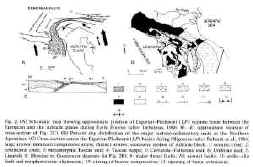Earth-Science Reviews, 34 (1993), 197-233
TECTONO-SEDIMENTARY CHARACTERISTICS OF LATE MIOCENE-QUATERNARY EXTENSIONAL
BASINS OF
THE NORTHERN APENNINES, ITALY
I.P. MARTINI1 and M. SAGRI2
1Department of Land Resource Science, University of Guelph, Guelph,
Ontario, N1G 2W1 Canada
2Dipartimento di Scienze della Terra, University of Florence, Florence
50121, Italy
¡¡
 Extensional and compressional regimes exist at the same time in adjacent
parts of the Northern Apennines (Italy), and the former regime succeeded the
latter at the same place as the thrust mountain front moved eastward since
Miocene times. Numerous extensional basins have developed west of the present
mountain divide. The westernmost ones formed over attenuated continental crust
since Late Miocene and have been subjected to several subsidence and uplift
events, with rates of subsidence generally faster than rates of sedimentation.
They contain continental deposits overlain by gypsum-bearing Upper Miocene
marine sequences and siliciclastic, marine Pliocene deposits. These basins were
affected by shallow magmatism and are still experiencing high geothermal
gradient and late to post-magmatic activities, such as in the renowned thermal
region of Larderello. To the east, closer to the present mountain divide, the
extensional basins formed later, from Pliocene to Quaternary, contain
continental (fluvial and lacustrine) deposits and have not experienced
near-surface magmatic activities.
Extensional and compressional regimes exist at the same time in adjacent
parts of the Northern Apennines (Italy), and the former regime succeeded the
latter at the same place as the thrust mountain front moved eastward since
Miocene times. Numerous extensional basins have developed west of the present
mountain divide. The westernmost ones formed over attenuated continental crust
since Late Miocene and have been subjected to several subsidence and uplift
events, with rates of subsidence generally faster than rates of sedimentation.
They contain continental deposits overlain by gypsum-bearing Upper Miocene
marine sequences and siliciclastic, marine Pliocene deposits. These basins were
affected by shallow magmatism and are still experiencing high geothermal
gradient and late to post-magmatic activities, such as in the renowned thermal
region of Larderello. To the east, closer to the present mountain divide, the
extensional basins formed later, from Pliocene to Quaternary, contain
continental (fluvial and lacustrine) deposits and have not experienced
near-surface magmatic activities.
The sedimentary fill
architecture of the Apennine extensional basins is similar to that of other
European, American and African extensional or transtensional systems. For
instance, a common characteristic is the prevalence of large alluvial fan
deposits at the hanging-wall shoulder of half-grabens, coarser, smaller,
alluvial fans at the footwall shoulder, and some fluvial deposits introduced
longitudinally. Unlike the African rifts though, the sedimentary facies
distribution of extensional basins which developed in active orogenic zones such
as in the Apennines, may be strongly affected by uplifting, steep mountain
slopes and can have large, thick, coarse alluvial fans also on the footwall side
of the half-grabens.